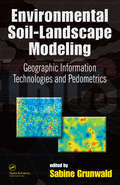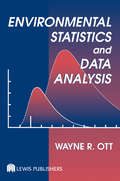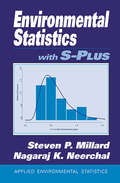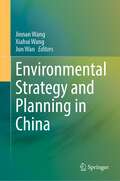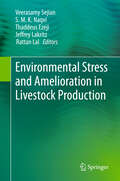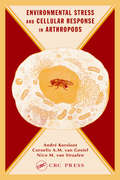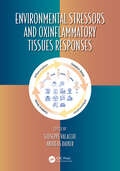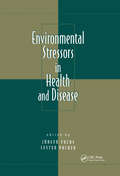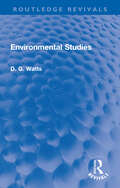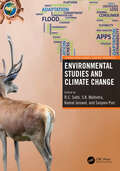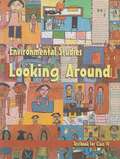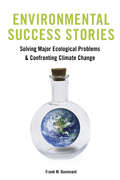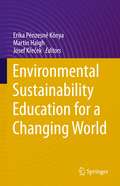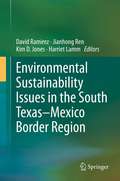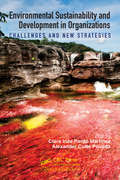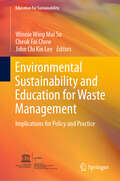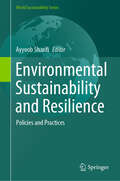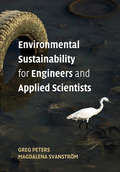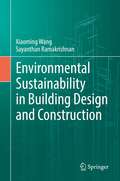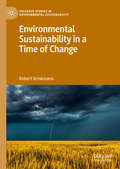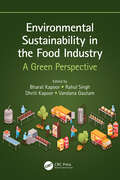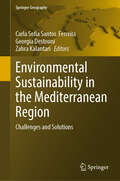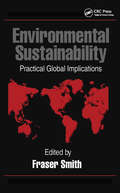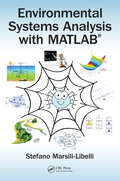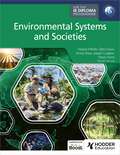- Table View
- List View
Environmental Soil-Landscape Modeling: Geographic Information Technologies and Pedometrics
by Sabine GrunwaldEnvironmental Soil-Landscape Modeling: Geographic Information Technologies and Pedometrics presents the latest methodological developments in soil-landscape modeling. It analyzes many recently developed measurement tools, and explains computer-related and pedometric techniques that are invaluable in the modeling process.This volume provi
Environmental Statistics and Data Analysis
by Wayne R. OttThis easy-to-understand introduction emphasizes the areas of probability theory and statistics that are important in environmental monitoring, data analysis, research, environmental field surveys, and environmental decision making. It communicates basic statistical theory with very little abstract mathematical notation, but without omitting importa
Environmental Statistics with S-PLUS
by Steven P. Millard Nagaraj K. NeerchalA clear, comprehensive treatment of the subject, Environmental Statistics with S-PLUS surveys the vast array of statistical methods used to collect and analyze environmental data. The book explains what these methods are, how to use them, and where to find references to them. In addition, it provides insight into what to think about before you coll
Environmental Strategy and Planning in China
by Jun Wan Jinnan Wang Xiahui WangThis book covers the research fields in biodiversity conservation, the Belt and Road eco-environmental cooperation, China's five-year plan for eco-environmental protection, sustainable development goals assessment, and human health loss assessment. In the past, these achievements have played an important scientific role in supporting China's ecological and environmental protection, and produced extensive social impacts and significant environmental benefits. At the same time, the relevant research ideas and methods also show the latest progress and trend in the field of environmental strategy and planning in China in recent years, which can be used for reference by experts and scholars of other countries in the field of ecological environment.
Environmental Stress and Amelioration in Livestock Production
by Rattan Lal Thaddeus Ezeji Veerasamy Sejian S.M.K. Naqvi Jeffrey LakritzGiven the importance of livestock to the global economy, there is a substantial need for world-class reference material on the sustainable management of livestock in diverse eco-regions. With uncertain climates involving unpredictable extreme events (e.g., heat, drought, infectious disease), environmental stresses are becoming the most crucial factors affecting livestock productivity. By systematically and comprehensively addressing all aspects of environmental stresses and livestock productivity, this volume is a useful tool for understanding the various intricacies of stress physiology. With information and case studies collected and analyzed by professionals working in diversified ecological zones, this book explores the influence of the environment on livestock production across global biomes. The challenges the livestock industry faces in maintaining the delicate balance between animal welfare and production are also highlighted.
Environmental Stress and Cellular Response in Arthropods
by Andre Korsloot Cornelis A. van Gestel Nico M. van StraalenWhile the subject of environmental stress in animals is broad, the available information is fragmentary and lacks an up-to-date overview and analysis. Environmental Stress and Cellular Response in Arthropods fills these knowledge gaps. Written by three experts from the same institution, the chapters have a consistency not often found in mult
Environmental Stressors and OxInflammatory Tissues Responses (Oxidative Stress and Disease #53)
by Giuseppe Valacchi Andreas DaiberEnvironmental risk factors – noise, air pollution, chemical agents, and ultraviolet radiation – impact human health by contributing to the onset and progression of noncommunicable diseases. Accordingly, there is need for preclinical and clinical studies and comprehensive summary of major findings. This book is a state-of-the-art summary of these myriad severe life stressors. The chapters on the different pollutants focus on disease mechanisms (cardiovascular, neurological and metabolic disorders) and on oxidative stress and inflammation. The editors emphasize emerging mechanisms based on dysregulation of the circadian clock, the microbiome, epigenetic pathways, and cognitive function by environmental stressors, and introduce the exposome concept while highlighting existing research gaps. Key Features: · Links various environmental stressors to the incidence of noncommunicable diseases · Includes chapters on airborne toxins, chemical pollutants, noise, and ultraviolet radiation stressors · Contributions from an international team of leading researchers · Summarizes the impacts of stressors on disease mechanisms
Environmental Stressors in Health and Disease
by Jurgen FuchsThis volume illustrates the impact of environmental oxidants on the tissues of the eyes, lungs and skin, as well as on the immune system - highlighting common illnesses, injuries and pathologies induced by pro-oxidant environmental xenobiotics such as inflammation, immune response, signal transduction, regulation of gene expression, and carcinogenesis. It provides clinical presentations and discusses the effects of environmental oxidants on target organs.
Environmental Studies (Routledge Revivals)
by D. G. WattsFirst published in 1969, Environmental Studies aims to fill up a major gap by surveying the ground for a structural theory of environmental studies for schools and colleges of education. This is not a handbook or manual of environmental studies but an exercise in curriculum development. It begins by examining the terminology and concepts employed in discussing environmental studies. The historical development of the idea is then traced and the relationship between environment and learning analysed. The conclusions reached from these inquiries are then used as a basis for outlining the aims and organisations of environmental studies courses, and practical application of such programmes is considered. Topical and lucid, this book is a must read for anyone interested to know the basics of environmental studies and also relevant for teachers and educationists.
Environmental Studies and Climate Change (Translating Animal Science Research)
by S. K. Malhotra Sanjeev Puri R. C. Sobti Kamal JaiswalCurrently, anthropogenic activities have caused unprecedented destruction of the environment at alarming rates, leading to undesirable alterations in air, land, and water. The process of environment degradation has been accelerated by industrial processes, which result in waste as well as over-consumption of natural resources. The ecological balance has been disturbed, and resources have shrunk. All this has resulted in climate change, which has emerged as a major concern in the 21st century. Changes in the environment are driven by demand for energy, water, and food to raise the standard of living. These are also responsible for climate change, with contributions from deforestation and CO2 emissions from fossil fuels such as coal and petroleum. The present volume discusses some of the main issues regarding environmental degradation and the causes as well as the impact of climate change, which is impacting the ecosystem. The effects of various pollutants, causes of climate change with case studies on geochemistry and glaciers, etc., and measures to reduce the impact on biodiversity, health, etc. are discussed in detail in its chapters. In a nutshell, this volume discusses in detail the following issues: • Anthropogenic and natural factors in environmental degradation • Climate change history, causes, and threats to abiotic and biotic systems • Case studies on the impact of climate change and living systems • Mitigation and preparedness for the future
Environmental Studies: Looking Around class 4 - NCERT - 23
by National Council of Educational Research and TrainingThe NCERT textbook "Environmental Studies - Looking Around" for Class IV provides a comprehensive introduction to environmental awareness for young learners. The book aims to instill a sense of responsibility and appreciation for the natural world among students. Through engaging narratives, colorful illustrations, and interactive activities, it covers diverse topics such as the importance of water, air, and soil, biodiversity, and the significance of conservation. The content is presented in a child-friendly manner, encouraging students to observe and understand their surroundings. The textbook not only imparts knowledge about the environment but also encourages students to develop a sustainable and eco-friendly mindset. With a focus on fostering curiosity and a sense of wonder, "Environmental Studies - Looking Around" serves as a valuable resource for nurturing environmentally conscious citizens from an early age.
Environmental Success Stories: Solving Major Ecological Problems and Confronting Climate Change
by Frank DunnivantUnlike many titles on environmental issues that portend a dark future, Environmental Success Stories delves into the most daunting ecological and environmental challenges humankind has faced and shows how scientists, citizens, and a responsive public sector have dealt with them successfully.In addition to presenting the basic chemical and environmental science underlying problems like providing clean drinking water, removing DDT and lead from agriculture and our homes, and curtailing industrial pollution, this book also discusses the political actors, agency regulators, and community leaders who have collaborated to enact effective legislation. Sharing the stories of the people, organizations, and governments who have addressed these problems successfully, Frank M. Dunnivant explains how we might confront the world's largest and most complex environmental crisis: climate change. Now is the time for rededicated scientific exploration and enlightened citizen action to save our environment, and Dunnivant's book offers a stirring call to action.
Environmental Sustainability Education for a Changing World
by Josef Křeček Martin Haigh Erika Pénzesné KónyaGlobally, there is a need to promote and empower practical action towards better environmental conservation and greater sustainability; education aspires to achieve and motivate this – one mind at a time. This book advances a future-oriented vision of the development of environmental sustainability education in settings outside the high-school. It provides practical guidance for teacher practitioners and policy makers in community-oriented environmental sustainability education. It promotes a modern holistic approach to sustainability learning in and by the community through participative engagement with sustainability issues. Its special foci include working with volunteers and citizen scientists, through museums or through re-purposing Higher Education. Its approach emphasises the implementation of the United Nation’s Sustainable Development Goals and cooperation with environmental management professionals. This book’s cosponsors include the International Association for Headwater Control and FAO – European Forestry Commission’s Working Party on the Management of Mountain Watersheds, as well as the International Environmental Education Conferences, Eger, Hungary and the Hungarian Academy of Science’s Subcommittee on Future Studies. Community education has long been a goal for environmental management, whose practitioners realise that interventions, such as biodiversity conservation, are only truly sustainable when supported by the local land-user and stakeholder communities; this depends upon these stakeholders’ understanding why intervention is necessary.
Environmental Sustainability Issues in the South Texas–Mexico Border Region
by Harriet Lamm Jianhong Ren David Ramirez Kim D. JonesEnvironmental sustainability issues in a fragile, semi-arid region and its coastal area, which experience climate changes from extreme drought conditions to the effects of hurricanes over a period of weeks to years, provide specific challenges for the ecosystems and the populations existing within the region. The research presented focuses on the problems and some solutions specific to the South Texas-Mexico border region, on both sides of the Rio Grande, focusing on water and air pollution.
Environmental Sustainability and Development in Organizations: Challenges and New Strategies
by Clara Inés Pardo MartínezThis book aims to analyze contexts and perspectives in the relationships between environmental sustainability, human development and organizations. The book combines different scientific approaches for enhancing our understanding of environmental sustainability, development economics and evaluate what the actual conditions in emerging economies are and how developing new process could improve the well-being of developing countries. Employing a collaborative and interdisciplinary approach, the authors work to determine the main related factors and outcomes of the relationship between challenges and new strategies in the environmental sustainability, ultimately seeking to guide public policies to enhance the welfare of the population of an emerging economy.
Environmental Sustainability and Education for Waste Management: Implications for Policy and Practice (Education for Sustainability)
by Cheuk Fai Chow Winnie Wing Mui So John Chi Kin LeeThis book focuses on education for environmental sustainability, in particular the area of solid waste management. Presenting the latest studies from different countries, industries and education sectors on the approaches and innovative ideas to educate future citizens regarding sustainable development of our planet, it is of interest to educators, academics, tertiary students, policy-makers, environmental scientists, social scientists and practitioners who have been involved in education, policy, science, and technological innovation for solid waste management.
Environmental Sustainability and Resilience: Policies and Practices (World Sustainability Series)
by Ayyoob SharifiThis volume offers a comprehensive exploration of the environmental challenges and innovations shaping our world. It represents a collective effort to understand and address the pressing issues that define our era, from climate change to resource management. Through a series of expert contributions, it examines the intricate relationship between human activity and the environment, seeking pathways to a more sustainable and just future. The insights presented are crucial for anyone looking to contribute to the global pursuit of Sustainable Development Goals. This volume is an invaluable resource for policymakers, researchers, educators, students, and activists alike; offering a well-rounded perspective on the multifaceted aspects of environmental sustainability - it's both a call to collective action as well as reminder urging us all—to rethink our strategies collaboratively towards achieving healthier world and more resilient planet.
Environmental Sustainability for Engineers and Applied Scientists
by Magdalena Svanström Greg PetersThis textbook presents key theoretical approaches to understanding issues of sustainability and environmental management, perfectly bridging the gap between engineering and environmental science. It begins with the fundamentals of environmental modelling and toxicology, which are then used to discuss qualitative and quantitative risk assessment methods, and environmental assessments of product design. It discusses how business and government can work towards sustainability, focusing on managerial and legal tools, before considering ethics and how decisions on environmental management can be made. Students will learn quantitative methods while also gaining an understanding of qualitative, legal, and ethical aspects of sustainability. Practical applications are included throughout, and there are study questions at the end of each chapter. PowerPoint slides and jpegs of all the figures in the book are provided online. This is the perfect textbook on environmental studies for engineering and applied science students.
Environmental Sustainability in Building Design and Construction
by Xiaoming Wang Sayanthan RamakrishnanThis monograph offers analyses of construction activities using various key concepts and assessments of sustainable development, and provides students and researchers with methodologies and design aspects for the sustainable development of the built environment. Additionally, the book demonstrates various national and international policies for assisting architects, engineers and policy makers in understanding the relevant decision-making approaches to sustainable development in construction. The book begins by reviewing the background of sustainability and sustainable development. The focus then turns to the effects of climate change on the built environment, including impacts of energy and carbon emissions, as well as constraints on water and waste management. The remaining chapters discuss the necessary approaches to achieve sustainable waste management, energy efficient building design, and resilience and adaptation in the built environment In eight chapters, the book encourages readers to think independently, logically and objectively about the complex issues presented by the applications of sustainable development in construction, including resource efficiency, environmental impacts, human health, building economics and social development.
Environmental Sustainability in a Time of Change (Palgrave Studies in Environmental Sustainability)
by Robert BrinkmannEnvironmental Sustainability in a Time of Change is the first book in a new Palgrave series on Environmental Sustainability. It takes a fresh look at the dynamic field of environmental sustainability by exploring the interconnections between climate change, water, energy, waste, land use, ecosystems, food, and transportation. It also provides an extensive summary on sustainability management, data analysis, mapping, and data sources. Brinkmann highlights how environmental sustainability challenges are distinctly different in the developed world, where sustainability is largely a choice, versus the developing world, where many struggle with basic existence due to war, migration, and water or food scarcity. He takes a broad systems and historic approach to contextualize environmental sustainability prior to the 1987 Brundtland Report and utilizes many contemporary examples throughout the text, analyzing numerous case studies from many areas of the world including China, Yemen, Malaysia, Egypt, and Florida. This book questions traditional approaches to sustainability that highlight the need for an equal balance of economic development, environmental protection, and social equality to achieve sustainability. This book focuses on a new line of thinking that places environmental sustainability as the key foundation in how to manage sustainability in a time of change. Our planet is quickly becoming environmentally unsustainable due to global consumption and unsustainable economic development and it is high time for a fresh approach. This book will be of great value to academics, practitioners, and students interested in environmental sustainability from a myriad of fields including geology, geography, biology, ecology, economics, business, sociology, anthropology, and other areas that intersect the interdisciplinary field of sustainability.
Environmental Sustainability in the Food Industry: A Green Perspective
by Rahul Singh Bharat Kapoor Dhriti KapoorCriticisms facing the food processing industry include adverse ecological impacts like decline in biodiversity, environmental degradation, water pollution, eutrophication, greenhouse gas emissions, and the loss of agricultural land. Environmental Sustainability in the Food Industry: A Green Perspective delves into the effect of food processing on the environment, human health, nutrition, energy efficiency, nanotechnology in food industry, and the maintenance of ecological sustainability. The book presents eco-friendly approaches to reducing the impacts of food processing on the environment and to promoting sustainable development. The focus of this text is how to implement green practices in the food industry to reduce the negative impacts of food processing on the ecosystem, as well as to improve food quality for better human health and nutrition. The text also explains the food industry’s focus on sustainable aspects in resource conservation and reduction of energy consumption. Key Features: Describes the contribution of the food industry sector on human health and nutrition Covers eco-friendly approaches to reducing negative impacts of food processing on the environment Discusses the uses of advanced techniques such as nanotechnology, non-thermal techniques, and more to improve food processing The book highlights details related to the food industry and environmental issues. It is a great resource for students, researchers, and professionals alike, as well as anyone with an interest in green paths to food quality and nutrition.
Environmental Sustainability in the Mediterranean Region: Challenges and Solutions (Springer Geography)
by Zahra Kalantari Carla Sofia Santos Ferreira Georgia DestouniThe book provides a cross sectoral assessment of the most relevant environmental challenges in the Mediterranean region, including land and water degradation, water and food security, and solution opportunities for these. It also discusses main change drivers, such as changes in climate, land use, population, demographics and technology. Additionally, the book explores improved management, participatory planning, and nature-based strategies and measures for meeting the key environmental challenges, e.g. restoring degraded areas and improving land management in different land uses (e.g. forest, coastal and urban areas). Finally, the book addresses needs and opportunities to improve governance and partnerships for assuring sustainable development in the Mediterranean region.
Environmental Sustainability: Practical Global Applications
by Fraser SmithIn 1994, representatives from all over the world met in Costa Rica to discuss the impact of ecological economics on developing countries. That groundbreaking conference laid the foundation for this new collection of research on environmental sustainability. While most discussions on sustainable development focus on the industrialized nations, Environmental Sustainability: Practical Global Applications takes a different angle: it presents the views of the developing countries themselves on issues such as wildlife resources in Nambia, timber production in Costa Rica, property rights and land reform in South Africa, and other steps being taken to implement environmentally sustainable economies around the world.This is an ideal text for students of natural and social sciences, development professionals and entrepreneurs seeking opportunities for ecologically sustainable businesses. Academics will find it useful as a source of current research and for making new contacts in the field. For anyone interested in exploring the link between man and his environment-specifically, the relationship between economics and ecology- Environmental Sustainability, is a must.
Environmental Systems Analysis with MATLAB®
by Stefano Marsili-LibelliExplore the inner workings of environmental processes using a mathematical approach. Environmental Systems Analysis with MATLAB® combines environmental science concepts and system theory with numerical techniques to provide a better understanding of how our environment works. The book focuses on building mathematical models of environmental systems, and using these models to analyze their behaviors. Designed with the environmental professional in mind, it offers a practical introduction to developing the skills required for managing environmental modeling and data handling. The book follows a logical sequence from the basic steps of model building and data analysis to implementing these concepts into working computer codes, and then on to assessing their results. It describes data processing (rarely considered in environmental analysis); outlines the tools needed to successfully analyze data and develop models, and moves on to real-world problems. The author illustrates in the first four chapters the methodological aspects of environmental systems analysis, and in subsequent chapters applies them to specific environmental concerns. The accompanying software bundle is freely downloadable from the book web site. It follows the chapters sequence and provides a hands-on experience, allowing the reader to reproduce the figures in the text and experiment by varying the problem setting. A basic MATLAB literacy is required to get the most out of the software. Ideal for coursework and self-study, this offering: Deals with the basic concepts of environmental modeling and identification, both from the mechanistic and the data-driven viewpoint Provides a unifying methodological approach to deal with specific aspects of environmental modeling: population dynamics, flow systems, and environmental microbiology Assesses the similarities and the differences of microbial processes in natural and man-made environments Analyzes several aquatic ecosystems’ case studies Presents an application of an extended Streeter & Phelps (S&P) model Describes an ecological method to estimate the bioavailable nutrients in natural waters Considers a lagoon ecosystem from several viewpoints, including modeling and management, and more
Environmental Systems and Societies for the IB Diploma (For the IB Diploma)
by Virginia D'Britto Öykü Dulun Emma Shaw Joseph CazabonDeveloped in cooperation with the International Baccalaureate® Ensure full coverage of the updated syllabus with a coursebook that implements inquiry-based and conceptually-focused teaching and learning, written by highly experienced global authors. - Explore the three key concepts in the new course: perspectives, systems and sustainability which allow students to deepen their understanding and make interdisciplinary connections throughout, with HL content clearly signposted. - Prepare students for assessment with a range of options: exam-style questions, top tip boxes and hints to help avoid common mistakes. - Integrate TOK into lessons and create opportunities for cross-curriculum study with case studies, real world examples and up-to-date data. - Provide plenty of practise with activities, review questions and chapter summaries allowing students to recap themes and test knowledge. - Enable students to feel confident in course terminology with ESL support, definitions, key terms and a glossary.
